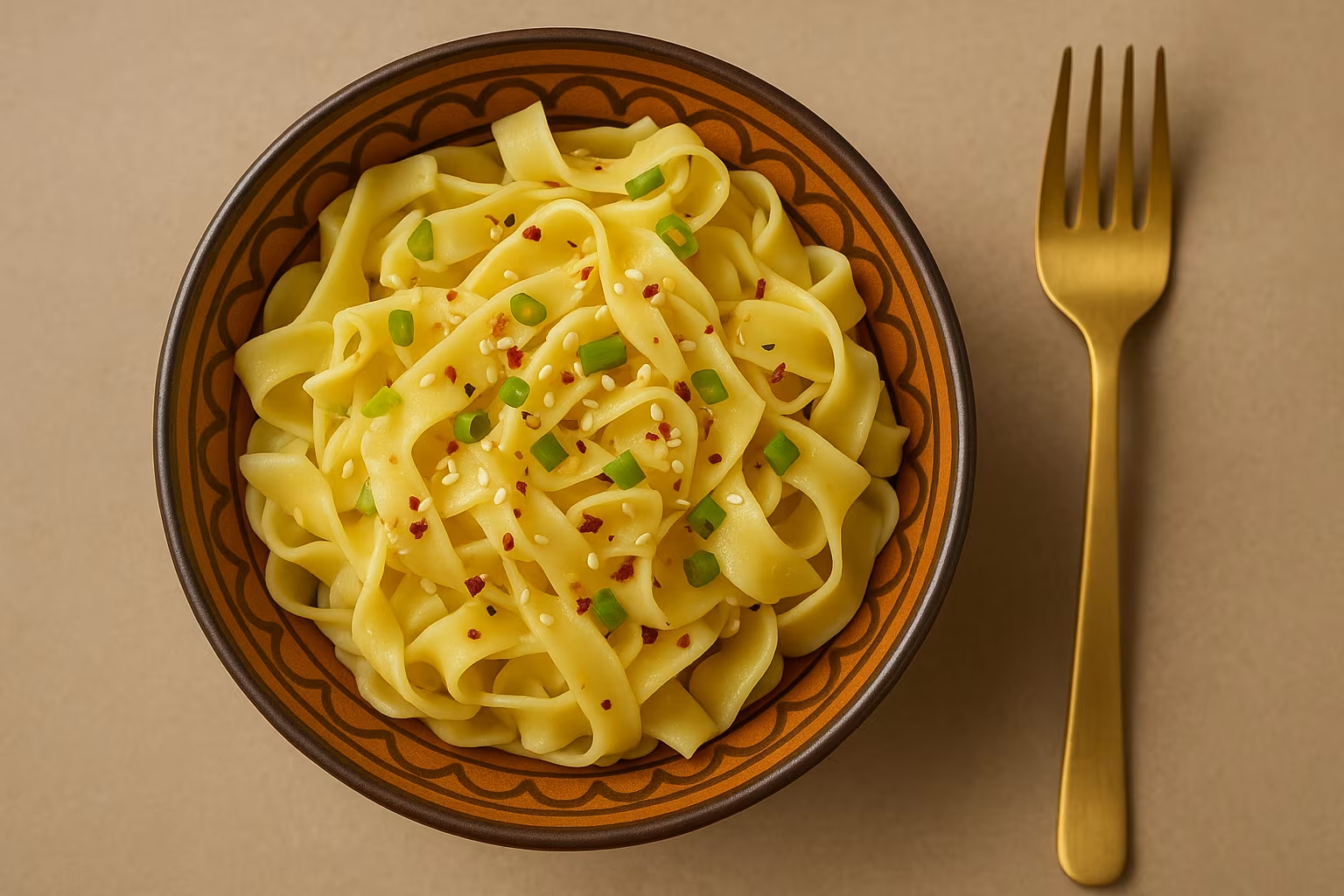If you’re someone who loves the comforting texture of egg noodles but must avoid gluten because of celiac disease, wheat allergy, or personal preference, you’ve likely wondered: Are egg noodles gluten free? Traditional egg noodles are made with wheat flour and hence contain gluten, which can cause a variety of health issues for sensitive people. But don’t worry! With the rise in demand for gluten free egg noodles and gluten free pasta alternatives, it’s easier than ever to get your fill of delicious noodles without gluten.
In this complete guide, you’ll discover how to make easy homemade gluten free egg noodles that capture the texture and taste of traditional noodles but are gluten-sensitive safe. Whether you’re new to gluten free cooking or an experienced home chef, this recipe and tips will help you create fresh, allergy-friendly noodles from scratch. Plus, we’ll dive into ingredient choices, tips for cooking, and how these noodles compare with other gluten free pasta options.
Understanding Gluten Free Egg Noodles
Before we jump into the recipe, it’s important to understand what makes gluten free egg noodles stand out from their traditional cousins.
Traditional egg noodles are usually produced from wheat flour, eggs, salt and water. Wheat flour contains gluten, a protein that provides dough with elasticity and chewiness. Gluten is what makes the typical pasta stretchy and firm, but it’s noxious to people with celiac disease or gluten intolerance.
Gluten free egg noodles use alternative flours that don’t contain wheat flour and gluten. Common gluten free flours are rice flour, tapioca starch, potato starch and sometimes corn or chickpea flour. These flours lack the binding qualities of gluten, so recipes often include eggs or gums such as xanthan gum to help the dough hold together and to have a similar texture.
Eggs are an important component in gluten free noodles and provide moisture, richness, and protein which help bind the dough and create a delicate bite. While gluten free flours differ in texture and ability to absorb water or fat, the right flours combined with eggs can make noodles that are surprisingly close in taste and texture to wheat-based egg noodles.
The demand for wheat-free diets is rapidly growing worldwide, thanks to a growing awareness of conditions associated with gluten, and a general trend towards allergy-friendly, clean eating. With this recipe you can create fresh homemade noodles that perfectly fit in your gluten free lifestyle.
Ingredients for Homemade Gluten Free Egg Noodles
To make gluten free egg noodles at home, you’ll need a few key ingredients to ensure that the dough comes together well and those noodles maintain their shape.
Essential Ingredients:
- Gluten free flour blend: A mix of rice flour, tapioca starch, and potato starch works best for texture and elasticity. You can buy pre-made gluten free all-purpose blends or measure your own.
- Eggs: Usually, 2-3 large eggs per cup of flour blend. Eggs add structure, protein, and moisture.
- Xanthan gum or guar gum (optional): Helps mimic gluten’s binding properties, improving elasticity and chewiness.
- Salt: Enhances flavor.
- Water (if needed): To adjust dough consistency.
Notes on Ingredients:
- Always use certified gluten free flours to prevent cross contamination.
- Some recipes include a teaspoon of oil or vinegar to add extra tenderness.
- Eggs are so important – they are what hold gluten free dough together.
Step-by-Step Recipe: How to Make Homemade Gluten Free Egg Noodles Easy
Now, let’s get into the heart of the matter — making your own gluten free egg noodles from scratch!
Step 1: Prepare Your Workspace
Lightly dust a clean surface with gluten free flour. Have your rolling pin, knife, or pasta cutter ready.
Step 2: Mix the Dough
In a large bowl, mix 2 cups of gluten free flour blend, 1 teaspoon of salt. If using, add 1 teaspoon of xanthan gum. Crack 3 large eggs into the flour and stir with fork to combine. The dough will begin to come together.
If the dough is too dry, add water a teaspoon at a time until the dough holds together but isn’t sticky. If it is too wet, add a bit more flour.
Step 3: Knead the Dough
Turn the dough out onto your floured surface and knead gently for 3-5 minutes. Gluten free dough will not be as elastic as wheat dough so be gentle so as not to crumble.
Step 4: Rest the Dough
Cover with plastic wrap and let stand for 20-30 minutes. This is to help moisten the flours and to roll them easier.
Step 5: Roll Out the Dough
Divide the dough into smaller portions. Using a rolling pin or pasta machine, roll each portion into thin sheets about 1/8 inch thick. Dust with flour to prevent sticking.
Step 6: Cut the Noodles
Cut the dough into strips of your desired width — thin for ramen-style or wider for traditional egg noodles. You can use a sharp knife, pizza cutter, or pasta cutter.
Step 7: Cook the Noodles
Bring a large pot of water with salt to boil. Add noodles carefully, and cook for 2-4 minutes, depending on thickness. Gluten free noodles to cook faster than wheat noodles, so keep an eye.
Check for doneness by tasting – noodles should be tender, but not mushy.
Step 8: Drain and Serve
Drain noodles in a colander and rinse for a short time under cold water to stop cooking and prevent clumping. Toss with a bit of oil or butter if you like.
Step 9: Storage
To store uncooked noodles, dust them with flour and freeze in airtight containers or bags. Cooked noodles, 2-3 days in the fridge.
Variations and Tips
- For gluten free ramen noodles, roll thinner dough and cut very thin noodles.
- Add herbs or spices such as turmeric or spinach powder as color and flavor.
- ADVANCED CHEF – Have your kids cook a meal for the other family members.
- If dough is too crumbly, add an extra egg or tablespoon of olive oil.
Comparing Gluten Free Egg Noodles to Other Gluten Free Pasta Alternatives
Gluten free pasta options are diverse but how do gluten free egg noodles stack up?
Rice Noodles
Rice noodles are naturally gluten free and are used in Asian cuisine. They’re light and soft but don’t have the richness of eggs
Corn Pasta
Corn-based pasta has a more rigid texture but also sometimes a stronger corn flavor that doesn’t suit all dishes.
Quinoa and Chickpea Pasta
Higher in protein and fiber but often more dense and earthy in taste.
Gluten Free Egg Noodles
Offer richer flavor and better chewiness because of eggs, making them great for hearty soups, stroganoff or casseroles.
Rice noodle vs egg noodle:
Rice noodles are great in stir-fries and soups where lightness is essential, while gluten free egg noodles shine in comfort dishes that require a tender, rich noodle.
Gluten Free Egg Noodles vs Gluten Free Noodles Timeline

Tips for Cooking and Using Gluten Free Egg Noodles
- Boil them in lots of salted water to keep them from sticking.
- Don’t overcook – gluten free noodles can turn mushy quickly.
- Rinse cooked noodles in cold water to halt the cooking and remove excess starch.
- Toss noodles with a little oil if not serving immediately.
- Use in soups, stir-fries or baked casseroles.
- Pair with gluten free sauces such as tomato, cream-based or Asian inspired broths
How to Incorporate Gluten Free Egg Noodles into Your Diet
- Use gluten free egg noodles in a classic chicken noodle soup for a comforting meal.
- Toss with some sauteed vegetables and a light sauce for a quick stir fry dinner.
- Combine with lean proteins such as grilled chicken or tofu to increase nutrition.
- You can store cooked noodles in an airtight container in the fridge for up to 3 days.
- Pair with bone broth to help with digestive health and provide additional nutrients.
Nutritional Benefits of Gluten Free Egg Noodles
Gluten free egg noodles are a great option for those with celiac disease or wheat sensitivity and can help avoid inflammation and digestive issues. Eggs provide a good source of protein, vitamins and minerals, while gluten free flours such as rice and potato starch are usually very easy to digest. Compared to wheat noodles, gluten free egg noodles can make a lighter option with less allergens – ideal for balanced meal planning.
Conclusion
Making your own easy homemade gluten free egg noodles is a satisfying way to enjoy favorite dishes gluten-free. With a few simple ingredients and some practice, you can create fresh, tender noodles that are perfect for soups, casserole and stir fries. By choosing gluten free flour and using eggs for that rich taste we’ve all known and loved, this recipe is a compromise between eating healthily and eating tasty comfort food.
We encourage you to try out this recipe, play with flavors and share your noodle-making adventures in the comments below. Gluten free cooking doesn’t have to be complicated – homemade egg noodles show that simple, allergy-free meals can be really satisfying!
Frequently Asked Questions
Are egg noodles gluten free?
Traditional egg noodles are not, but this homemade egg noodles recipe uses gluten free flours.
Can I substitute gluten free egg noodles in any recipe?
Yes but adjust cooking times as gluten free noodles can cook faster and can be more delicate.
How do gluten free egg noodles taste?
They are similar in rich, eggy flavor but have a somewhat different texture – tender but less chewy than wheat noodles.
How should I store gluten free egg noodles?
Store uncooked noodles in the freezer or cooked noodles in the refrigerator, in airtight containers, for a maximum of 3 days.
Where can I buy gluten free pasta ingredients?
Health food stores, online retailers or specialty gluten free brands sell certified gluten free flours and xanthan gum.











